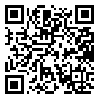BibTeX | RIS | EndNote | Medlars | ProCite | Reference Manager | RefWorks
Send citation to:
URL: http://jria.iust.ac.ir/article-1-544-en.html
In order to achieve a new Islamic civilization, in between science topics such as creating works of art and architecture, it is necessary to present a conceptual model and a foundation. In terms of structure and process, this model should be comprehensive and content of each stage of the sources must be explicated according to islamic rules. In addition, this model should provide a structure, so that we can evaluate the quantitative and qualitative aspects of human processes and we should be able to criticize it. In thishandbook we have explain the human processes in five stages andcompulsory human processes (based on Figure - 1) are explained.
In the first stage: determination (world and people) Islamic point of view :
At this stage of actual and potential positive and negative tendencies of human beings and their needs and their relations with each other and the world of the comparative study and analysis between Islam and other schools in the world. This step is important threads about anthropology, epistemology, god, ontology, sociology, philosophy, history and the human relationship with the natural environment and artificial world as a whole. Of topics (beliefs)and the above categories (needs and instinctive inclination) people and the concept ( Aesthetics) will be concluded by the Islamic laws.
In the second phase: the category (motivations and intentions) is voluntary and optional for every human beings.
From the perspective of Islamic motives, it is classified in five (solvents, recommended, permissible, detestable and forbidden) categories. They are called (five basic sentences ).
In the third phase: one based on perception internal motivations (conceptual and divine) wants to practice or work in the natural world, made in(Material and natural forms). Islam (the Shia school) has ten principles to concepts and forms of expression in the world of nature, which is subjective. . The humanitarian principles enables (artists, architects and urban planners) to make a detailed program and so would realize the conceptual and temporal and spatial learning with respect to the total circumstances of time and place in the natural world.
In the fourth phase: Based on the previous steps and talented person (speech, behavior or works) is produced which generally is manifested in the phenomenon of his ideas.
From an Islamic perspective, the phenomena like (incarnation) or (neutral), are nothing but a sign, such as human relationship with his own image.
In the fifth phase: works of man, material and spiritual has an impact on the audience and the subject. Material impacts are a mandatory issue and are related to the overall environmental conditions. But the spiritual influence is optional and depends on the relative audience. Artists and audiences have also two linkages. A relationship (innate, kind, eternal and fixed) and one type of relationship (relative, multiple, variable) is dependent on the total circumstances of time and place.
Islamic culture in the Shiite-based research methodology of this thesis is based on two source (wisdomand story). The above data through methods (logic) and (commentary - analysis) are investigated and approved.
According to Islam, what is (scientific), is rational and what is rational, is (Islamic) and the sources and bases of the above can be assessed and approved. In the process of this treatise, the relation of Islamic ideology with each one of the above-mentioned sources and bases will be discovered, assessed and compared with other competitive ideologies. At the end two tables will be introduced to assess the human processes. In the first table the quality impacts and content impacts will be studied and reviewed (figure number-2).
And in the second table, the effect of quantity and engineering work will be evaluated. (Figure - 3)
It can opens the door to reform of educational programs on topics such as between knowledge like (arts and architecture and urbanism).
And methods of research and design and construction management processes at all levels, are from an Islamic perspective and assist the executives and experts to assess the effects of those works.
Received: 2016/12/20 | Accepted: 2016/12/20 | Published: 2016/12/20
| Rights and permissions | |
 |
This work is licensed under a Creative Commons Attribution-NonCommercial 4.0 International License. |





